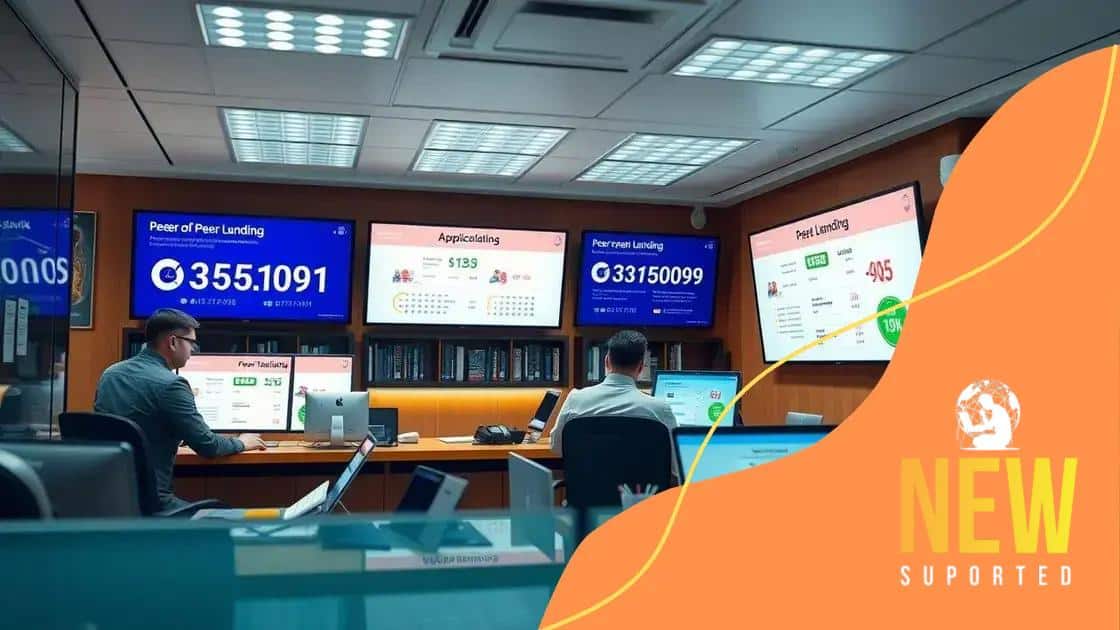How peer-to-peer lending impacts traditional banks

Peer-to-peer lending impacts traditional banks by providing lower interest rates and faster access to funds, forcing banks to innovate in their services to remain competitive in a changing financial landscape.
How peer-to-peer lending impacts traditional banks is a pressing question in today’s financial landscape. With the rise of P2P platforms, many are curious about how this shift might change their relationships with banks. Let’s take a closer look at these changes.
Understanding peer-to-peer lending
Peer-to-peer (P2P) lending is revolutionizing the way individuals borrow and lend money. This innovative approach connects borrowers directly with lenders through online platforms, minimizing the need for traditional financial institutions. Understanding how peer-to-peer lending works is crucial for anyone looking to navigate this new landscape.
How Does Peer-to-Peer Lending Work?
In P2P lending, borrowers apply for loans on online platforms. These platforms assess their creditworthiness and then match them with individual lenders willing to fund their loans. The process is typically faster and more efficient than traditional banking methods.
Benefits of P2P Lending
- Lower Interest Rates: Borrowers often find better rates compared to banks because there are fewer overhead costs.
- Access to Credit: Individuals with limited credit histories may find it easier to obtain loans.
- Diversified Investment Opportunities: Lenders can invest smaller amounts in multiple loans, spreading risk.
P2P lending platforms also offer transparency. Borrowers can see the terms and conditions clearly, while lenders receive information about borrowers’ profiles. This enables informed decisions and builds trust within the lending community.
Risks Associated with Peer-to-Peer Lending
As with any financial product, there are risks involved in P2P lending. For instance, borrowers might default on their loans, which can result in losses for lenders. Additionally, regulatory environments are evolving and may impact the future of these platforms.
Despite these challenges, P2P lending continues to grow as more individuals seek flexible and accessible financial solutions. By understanding how peer-to-peer lending functions, both borrowers and lenders can make more informed choices in this dynamic marketplace.
Effects on traditional banking models

The rise of peer-to-peer (P2P) lending is significantly affecting traditional banking models. As more people turn to P2P platforms for loans, traditional banks are feeling the pressure to adapt. This shift toward peer-to-peer lending is reshaping how banks operate and the services they offer.
Changes in Consumer Preferences
One major effect of P2P lending is the change in consumer preferences. Many borrowers are now looking for faster and more flexible loan options than what traditional banks provide. With P2P lending, borrowers can often receive funds in a matter of days, whereas traditional banks may take weeks.
Increased Competition
As P2P lending becomes more mainstream, banks are facing increased competition. This competition is pushing banks to lower their interest rates and improve their services to retain customers. In response, some banks are also starting to adopt similar technologies used in P2P lending to enhance their efficiency.
- Lower borrowing costs: Traditional banks may reduce costs to compete with P2P platforms.
- Innovative services: Banks are exploring new technologies to offer quicker loan processing.
- Enhanced customer experience: Personalization and improved customer service are becoming priorities.
Moreover, traditional banks are not only adjusting their loan offerings. They are also reevaluating their overall strategies. Some banks are forming partnerships with P2P platforms to leverage their technology and customer base. This collaboration can lead to new product offerings that blend the best features of both banking and P2P lending.
Regulatory Implications
The rise of P2P lending also raises important questions regarding regulation. As these platforms grow, regulators are taking notice. This can lead to new rules that may impact both P2P lending and traditional banks in significant ways. Ensuring consumer protection while fostering innovation will be a key challenge for regulators.
The impact on traditional banking models is profound and ongoing. As the financial landscape evolves, banks must find ways to adapt to the changing environment shaped by the growth of peer-to-peer lending, ensuring they remain relevant to current and future consumers.
Consumer benefits and risks
Peer-to-peer (P2P) lending offers consumers unique benefits, but it’s crucial to recognize the associated risks. Understanding both sides helps borrowers make better financial decisions. Many are drawn to P2P lending for its flexibility and potential savings on interest rates.
Benefits of P2P Lending
One of the main benefits of P2P lending is the ability to secure loans at lower interest rates compared to traditional banks. Since these platforms cut out the middleman, borrowers can save money over time. Additionally, the application process is typically quicker and more streamlined. Many consumers appreciate applying online without the hassle of in-person visits.
- Access to varied funding: Borrowers can find multiple lenders willing to support their needs.
- Improved chances for those with low credit: Even individuals with lower credit scores may secure funding.
- Transparent terms: Borrowers receive clear information about rates and fees up front.
Moreover, P2P lending can provide funds for a variety of purposes, from consolidating debt to funding personal projects. This versatility is appealing to many consumers looking for financial solutions tailored to their needs.
Risks of P2P Lending
Despite its benefits, there are risks involved in P2P lending. The most significant risk is the possibility of borrower default. If the individual fails to repay the loan, lenders may lose their invested funds. This uncertainty can deter some potential investors from participating.
Another risk is the lack of regulation compared to traditional banks. While regulations are evolving, P2P platforms often operate in a less controlled environment, which can lead to unfamiliar risks for both borrowers and lenders.
- Variable loan terms: Not all loans have the same rates or conditions, leading to potential misunderstandings.
- Potential for higher fees: Some platforms might charge fees that could impact the total cost of the loan.
- Economic fluctuations: Changes in the economy can affect the likelihood of on-time repayments.
Understanding the consumer benefits and risks of P2P lending is essential for making informed decisions. By weighing these factors, individuals can better navigate their choices in the evolving financial landscape.
Regulatory challenges and responses

The growth of peer-to-peer (P2P) lending has brought about various regulatory challenges that governments and financial authorities are starting to address. As this lending model grows in popularity, it outpaces the existing regulations meant for traditional financial institutions. It is essential to understand how regulations are evolving in response to this change.
Understanding Regulatory Issues
P2P lending operates in a different environment compared to banks. This difference raises important questions about the protection of consumers and investors. With a focus on security and transparency, regulators are keen to ensure that P2P platforms operate fairly. However, setting clear guidelines for these platforms has been challenging.
Possible Regulatory Responses
There are several ways regulatory bodies can respond to the unique challenges posed by P2P lending. These responses aim to create a safer environment for all parties involved. Potential regulatory actions include:
- Establishing clear licensing requirements: Governments can require P2P platforms to obtain licenses, ensuring they adhere to specific standards.
- Consumer protection regulations: Implementing rules that safeguard the rights of borrowers and lenders can help build trust and accountability.
- Risk assessment frameworks: Developing frameworks for assessing the creditworthiness of borrowers can reduce defaults and enhance lender security.
Furthermore, regulators may also explore guidelines to encourage transparency in how P2P platforms operate. Transparency helps borrowers understand loan terms and ensures that lenders know the risks involved. As this sector continues to evolve, the dialogue between regulatory bodies and P2P platforms will be crucial in shaping a balanced approach to governance.
The Role of Industry Collaboration
The P2P lending industry can play an active role in addressing regulatory challenges. By collaborating with regulators, these platforms can help develop effective frameworks that protect consumers while fostering innovation. This partnership can create an ecosystem where both parties learn from each other, adapting to changes in technology and consumer behavior.
Overall, understanding the regulatory challenges and responses in P2P lending is vital for anyone considering borrowing or investing in these platforms. By staying informed, individuals can make better decisions in this rapidly changing financial landscape.
Future of banking in a P2P world
The peer-to-peer (P2P) lending model is changing the future of banking. As consumers become more familiar with P2P platforms, their expectations of financial services evolve. This shift means that traditional banks must adapt or risk becoming less relevant in this new landscape.
Emerging Trends in Financial Services
One key trend is the demand for digital solutions. Consumers want fast, convenient access to financial services, which P2P lending platforms typically provide. This includes everything from quick loan approvals to efficient online management of finances.
Blending Traditional Banking and P2P
Many traditional banks are beginning to recognize the importance of innovation in staying competitive. Some are forming partnerships with P2P platforms or adopting similar technologies. This blend allows banks to offer more flexible and user-friendly products while still retaining their customer base. For instance, banks might start using algorithms from P2P systems to assess credit risks more accurately.
- Enhanced user experience: Banks will need to simplify their processes to compete effectively.
- New product offerings: The integration of peer-to-peer models may lead to innovative loan products and services.
- Focus on customer service: Retaining customers will involve improving and personalizing service delivery.
The shift towards a P2P world also raises questions about regulatory hurdles and consumer protections. As traditional banks adapt, they must ensure compliance with regulations while remaining competitive. This may lead to new laws that shape how both banks and P2P platforms operate.
The Role of Technology
Technology will continue to play a central role in the future of banking. With advanced data analytics and machine learning, banks and P2P platforms can better predict consumer needs and tailor their offerings. This shift not only benefits consumers but can also lead to greater financial inclusion.
In a future where banking becomes increasingly intertwined with P2P lending, retaining trust will be essential. Transparency in transactions, clear communication, and robust security measures will help build confidence among users. As these changes unfold, the banking industry is likely to become more dynamic, with both banks and P2P platforms working together to meet the financial needs of consumers.
In conclusion, peer-to-peer (P2P) lending is significantly reshaping the financial landscape. As this model gains popularity, it’s crucial for both consumers and traditional banks to adapt. Consumers benefit from lower interest rates and simplified processes, but they must also understand the risks involved. Meanwhile, traditional banks are learning to innovate and embrace new technologies to stay competitive. The future of banking will likely see a blend of traditional methods and P2P solutions, ultimately creating a more dynamic financial environment. By staying informed and engaged, all parties can navigate this evolving landscape successfully.
FAQ – Frequently Asked Questions about Peer-to-Peer Lending and Banking
What is peer-to-peer lending?
Peer-to-peer lending is a method where individuals can borrow and lend money directly through online platforms, bypassing traditional banks.
What are the main benefits of using P2P lending?
The main benefits include lower interest rates, faster access to funds, and the ability for borrowers with less-than-perfect credit to secure loans.
How does P2P lending affect traditional banks?
P2P lending introduces competition, prompting traditional banks to innovate and adjust their offerings to better meet consumer demands.
What should borrowers be aware of when using P2P lending platforms?
Borrowers should be aware of potential risks, including interest rates, fees, and the possibility of default, ensuring they fully understand the terms before proceeding.






